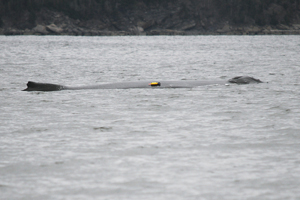By partially or completely obstructing a watercourse, an ice jam often causes significant flooding in areas near the shores. This phenomenon has been noted on the St. Lawrence River several times, causing damage to properties on the shoreline.

All news
Booms Complementing Icebreakers 
|
Species at Risk: Success for the Comité ZIP du lac Saint-Pierre Two years after completing work to reduce siltation affecting aquatic grass beds around Île de Grâce in the Archipelago of Lake Saint-Pierre, the ZIP Committee points out that its investment has paid off. 
|
Funding for Research on the Effects of Contaminants on Aquatic Species Last June, Fisheries and Oceans Canada, through the National Contaminants Advisory Group, launched a second call for research proposals on the evaluation of the biological effects of contaminants on aquatic species. The invitation was addressed to researchers from Canadian universities and non-profit research organizations. 
|
Potential Impacts of Global Warming on the Snow Crab If climate change is sustained, the surface and bottom waters of the Gulf of St. Lawrence will continue to become warmer. Some species caught in the Gulf, such as Lobster,will benefit while others will suffer. This is the case with the snow crab because it is more dependent on cold water than any other species fished in the Gulf of St. Lawrence. 
|
Network of Marine Protected Areas for the Conservation of Ecosystems in the Estuary and Gulf of St. Lawrence In collaboration with its partners, Fisheries and Oceans Canada is committed to conserving coastal and marine ecosystems by means of Marine Protected Area Networks. The Minister therefore intends to work with other federal departments and provincial governments to develop a network to conserve natural resources in the Estuary and Gulf of St. Lawrence. 
|
The St. Lawrence Estuary: A Whale's Pantry The Estuary and Gulf of St. Lawrence encompass major summer feeding grounds for large cetaceans like the blue whale, fin whale and common minke whale, that forage there. A Fisheries and Oceans Canada team of scientists recently plied the St. Lawrence, from the head of the Laurentian Channel to Gaspé, on their eighth annual survey of the area to study how forage species such as krill and sand lance affect baleen whale distribution. 
|
New Regional Director General for Quebec Fisheries and Oceans Canada is pleased to announce the appointment of Patrick Vincent as Regional Director General for Quebec. He is taking over from Richard Nadeau, who retired in August 2015. 
|
Dedication of New Fisheries Patrol Vessel, CCGS A. LeBlanc CCGS A. LeBlanc, a new fisheries patrol vessel, was officially dedicated on July 9, 2015 in Gaspé Harbour. Its mandate is to enforce fisheries regulations in the Gulf of St. Lawrence. 
|
Diving with Blue Whales to Find Out What They Eat! Diving with whales! We can only imagine it, since diving with blue whales or any other marine mammal is prohibited in the St. Lawrence. But this summer, a team of scientists used small electronic devices to do just that, as part of a project to find out where, when and what blue whales in the St. Lawrence eat. Fisheries and Oceans Canada researcher Véronique Lesage is leading this project for a fourth year in collaboration with the Group for Research and Education on Marine Mammals (GREMM) and the Saguenay–St. Lawrence Marine Park. 
|
New Assistant Commissioner for Central and Arctic Region The Canadian Coast Guard (CCG) is pleased to announce the appointment of Julie Gascon as Assistant Commissioner for the Central and Arctic Region. As of August 2015, she takes over from Mario Pelletier, who has been promoted to the position of Deputy Commissioner of Operations. 
|